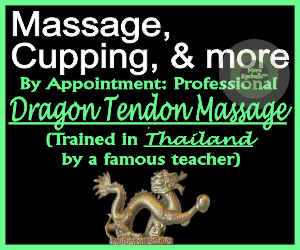- Joined
- Aug 8, 2009
- Messages
- 1,417
- Reaction score
- 962
- Points
- 113
[TABLE="class: c18, align: right"]
[TR]
[TD="align: left"] [/TD]
[TD="width: 10"]*[/TD]
[TD="width: 70, align: right"]
 [/TD]
[/TD]
[TD="width: 5"]*[/TD]
[TD="width: 30, align: right"] [/TD]
[/TR]
[/TABLE]
Massage Today
June, 2013, Vol. 13, Issue 06 By Massage Therapy Foundation Contributor
Contributed By Sandra K. Anderson, BA LMT ABT; MK Brennan, MS RN LMBT; Jolie Haun, PhD EdS LMT
The Massage Therapy Foundation is always looking for new research that is helpful for massage therapists.
This month we are reporting on "The Effects of Massage Therapy on Pain Management in the Acute Care Setting," published in the March 2010 issue of the International Journal of Therapeutic Massage and Bodywork. The authors of this publication, Adams and colleagues, suggest pain management within the acute care setting is a focus of empirical study by researchers, healthcare facilities and accreditation organizations throughout the United States. Previous studies have shown that high levels of stress and anxiety increase pain, and delay hospital patients' recovery by limiting movement and self-care activities, while also reducing quality of sleep. In the hospital setting, stress is due to factors such as excessive noise, social isolation and pain from procedures. In fact, in the acute care setting, clinical procedures are often the only time patients receive touch.
Literature indicates massage therapy is the complementary and integrative medicine (CIM) treatment most often prescribed by physicians that is beneficial without adverse effects. Because massage therapy may be effective in reducing pain through the gate control theory, as well as the relaxation response, it may also play a role in psychological healing along with physical healing. Adams and colleagues conducted this study in the acute healthcare setting to examine the impact of massage therapy on pain and well-being. To account for both psychological and physical effects, the authors included quantitative and qualitative methods.
The study recruited 65 inpatients in various hospital units, admitted between October 1, 2006 and March 31, 2007, at a hospital in a large rural area in the southwest United States. Study inclusion requirements included a physician order for massage, as well as the ability of the patient or a family member to provide consent. Additionally, feedback about the massage and return of a qualitative survey after hospital discharge were collected.
 Three licensed massage therapists employed by the hospital provided massage. Each was trained in working with hospitalized or medically frail patients. The massage sessions were 15 to 45 minute sessions given to patients at bedside. The session length varied depending on the patient's energy level and availability. Techniques used included effleurage, petrissage, acupressure, craniosacral therapy, cross-fiber friction and pressure point therapy. The head, neck, shoulders, back and feet were areas most commonly massaged depending on the patient's needs, with patients either supine or in side-lying position. Contraindication for massage sites included areas of injury, surgery or intravenous lines.
Three licensed massage therapists employed by the hospital provided massage. Each was trained in working with hospitalized or medically frail patients. The massage sessions were 15 to 45 minute sessions given to patients at bedside. The session length varied depending on the patient's energy level and availability. Techniques used included effleurage, petrissage, acupressure, craniosacral therapy, cross-fiber friction and pressure point therapy. The head, neck, shoulders, back and feet were areas most commonly massaged depending on the patient's needs, with patients either supine or in side-lying position. Contraindication for massage sites included areas of injury, surgery or intravenous lines.
Patients indicated their levels of pain before and after receiving massage using a visual analog scale (VAS). The VAS consists of a horizontal line with "0" at 1 end and "10" at the other, with 0 indicating no pain and 10 indicating severe pain. At the completion of the patient's last session, a survey was given asking about length of hospital stay, number of massages received and the impact of the massage on overall pain levels, emotional well-being, ability to move, ability to participate in therapies, relaxation, ability to sleep and recovery. Additionally, participants were asked if they thought massage therapy had an effect on their need for pain medication, how long the effects of the massage had lasted and whether they planned to continue using massage therapy as part of their healing process. An open-ended inquiry at the end of the survey encouraged participants to comment freely about massage. These results, along with demographic data, number of massage sessions and nursing comments were also analyzed.
Of the initial 65 participants, 53 completed the research project. Most participants received one massage, many received two to three massages, and a few received more than three massages. Sessions lasted between 15 and 45 minutes with most being about 30 minutes. The pre-massage pain levels had a mean score of 5.18 on the VAS and the post-massage mean score was 2.33, indicating that the pain level decreased by more than half. The effects of the massage lasted one to four hours for most participants. Some felt they lasted four to eight hours and a few felt they lasted anywhere from eight to over 24 hours. No negative effects from the massage were reported by the participants. The results of the survey included significant reduction in overall pain and need for pain medication as well as an increase in emotional well-being, relaxation and ability to sleep. Over two-thirds of the participants said they planned to continue using massage therapy as part of their healing process.
The results of the study are promising. According to the article, "The fact that patients throughout the various hospital units, with a wide variety of pre-massage pain levels, experienced relaxation through massage therapy indicates the true potential for massage to support healing for hospitalized patients." Additionally, massage therapy relieved the sense of isolation the patients felt. Because so many participants reported increased emotional well-being, the authors suggest it is possible it could be due to the need for compassionate human touch.
Study limitations included only participation by those adults with health status that allowed them to receive massage and to complete the study paperwork. Patients whose energy or pain levels prevented them from participating may have provided information indicating other results. Another limitation is that physiological indicators of pain such as heart rate, blood pressure and oxygen levels were not collected. Finally, a minimal sample size was used with no control group; mainly due to the additional cost this would have incurred.
As researchers in the field continue to pursue understanding the role of massage in pain management, massage therapists can leverage these research findings to promote the need for skilled touch in hospitals to help patients heal. Adams and colleagues suggest, "The further integration of CIM therapies such as massage into the hospital offers the possibility to improve the experience for patients who face physical, psychological, and social challenges in an unfamiliar environment."
As health care systems continue to transform, it is possible that massage therapy will be more widely recognized as essential for patients in the acute care setting. Moving forward massage therapists can reference this work and other research on pain management in the healthcare setting to support the use of massage in the clinical care environment. To learn more about the effects of massage therapy, you can review the Massage Therapy Foundation article archives, read accepted MTF Research Grant summaries, or search PubMed for massage therapy studies.
Source:
Click here for more information about Massage Therapy Foundation Contributor.

Please enable JavaScript to view the comments powered by Disqus.
comments powered by

[TR]
[TD="align: left"] [/TD]
[TD="width: 10"]*[/TD]
[TD="width: 70, align: right"]
[TD="width: 5"]*[/TD]
[TD="width: 30, align: right"] [/TD]
[/TR]
[/TABLE]
Massage Today
June, 2013, Vol. 13, Issue 06 By Massage Therapy Foundation Contributor
Contributed By Sandra K. Anderson, BA LMT ABT; MK Brennan, MS RN LMBT; Jolie Haun, PhD EdS LMT
The Massage Therapy Foundation is always looking for new research that is helpful for massage therapists.
This month we are reporting on "The Effects of Massage Therapy on Pain Management in the Acute Care Setting," published in the March 2010 issue of the International Journal of Therapeutic Massage and Bodywork. The authors of this publication, Adams and colleagues, suggest pain management within the acute care setting is a focus of empirical study by researchers, healthcare facilities and accreditation organizations throughout the United States. Previous studies have shown that high levels of stress and anxiety increase pain, and delay hospital patients' recovery by limiting movement and self-care activities, while also reducing quality of sleep. In the hospital setting, stress is due to factors such as excessive noise, social isolation and pain from procedures. In fact, in the acute care setting, clinical procedures are often the only time patients receive touch.
Literature indicates massage therapy is the complementary and integrative medicine (CIM) treatment most often prescribed by physicians that is beneficial without adverse effects. Because massage therapy may be effective in reducing pain through the gate control theory, as well as the relaxation response, it may also play a role in psychological healing along with physical healing. Adams and colleagues conducted this study in the acute healthcare setting to examine the impact of massage therapy on pain and well-being. To account for both psychological and physical effects, the authors included quantitative and qualitative methods.
The study recruited 65 inpatients in various hospital units, admitted between October 1, 2006 and March 31, 2007, at a hospital in a large rural area in the southwest United States. Study inclusion requirements included a physician order for massage, as well as the ability of the patient or a family member to provide consent. Additionally, feedback about the massage and return of a qualitative survey after hospital discharge were collected.
 Three licensed massage therapists employed by the hospital provided massage. Each was trained in working with hospitalized or medically frail patients. The massage sessions were 15 to 45 minute sessions given to patients at bedside. The session length varied depending on the patient's energy level and availability. Techniques used included effleurage, petrissage, acupressure, craniosacral therapy, cross-fiber friction and pressure point therapy. The head, neck, shoulders, back and feet were areas most commonly massaged depending on the patient's needs, with patients either supine or in side-lying position. Contraindication for massage sites included areas of injury, surgery or intravenous lines.
Three licensed massage therapists employed by the hospital provided massage. Each was trained in working with hospitalized or medically frail patients. The massage sessions were 15 to 45 minute sessions given to patients at bedside. The session length varied depending on the patient's energy level and availability. Techniques used included effleurage, petrissage, acupressure, craniosacral therapy, cross-fiber friction and pressure point therapy. The head, neck, shoulders, back and feet were areas most commonly massaged depending on the patient's needs, with patients either supine or in side-lying position. Contraindication for massage sites included areas of injury, surgery or intravenous lines.Patients indicated their levels of pain before and after receiving massage using a visual analog scale (VAS). The VAS consists of a horizontal line with "0" at 1 end and "10" at the other, with 0 indicating no pain and 10 indicating severe pain. At the completion of the patient's last session, a survey was given asking about length of hospital stay, number of massages received and the impact of the massage on overall pain levels, emotional well-being, ability to move, ability to participate in therapies, relaxation, ability to sleep and recovery. Additionally, participants were asked if they thought massage therapy had an effect on their need for pain medication, how long the effects of the massage had lasted and whether they planned to continue using massage therapy as part of their healing process. An open-ended inquiry at the end of the survey encouraged participants to comment freely about massage. These results, along with demographic data, number of massage sessions and nursing comments were also analyzed.
Of the initial 65 participants, 53 completed the research project. Most participants received one massage, many received two to three massages, and a few received more than three massages. Sessions lasted between 15 and 45 minutes with most being about 30 minutes. The pre-massage pain levels had a mean score of 5.18 on the VAS and the post-massage mean score was 2.33, indicating that the pain level decreased by more than half. The effects of the massage lasted one to four hours for most participants. Some felt they lasted four to eight hours and a few felt they lasted anywhere from eight to over 24 hours. No negative effects from the massage were reported by the participants. The results of the survey included significant reduction in overall pain and need for pain medication as well as an increase in emotional well-being, relaxation and ability to sleep. Over two-thirds of the participants said they planned to continue using massage therapy as part of their healing process.
The results of the study are promising. According to the article, "The fact that patients throughout the various hospital units, with a wide variety of pre-massage pain levels, experienced relaxation through massage therapy indicates the true potential for massage to support healing for hospitalized patients." Additionally, massage therapy relieved the sense of isolation the patients felt. Because so many participants reported increased emotional well-being, the authors suggest it is possible it could be due to the need for compassionate human touch.
Study limitations included only participation by those adults with health status that allowed them to receive massage and to complete the study paperwork. Patients whose energy or pain levels prevented them from participating may have provided information indicating other results. Another limitation is that physiological indicators of pain such as heart rate, blood pressure and oxygen levels were not collected. Finally, a minimal sample size was used with no control group; mainly due to the additional cost this would have incurred.
As researchers in the field continue to pursue understanding the role of massage in pain management, massage therapists can leverage these research findings to promote the need for skilled touch in hospitals to help patients heal. Adams and colleagues suggest, "The further integration of CIM therapies such as massage into the hospital offers the possibility to improve the experience for patients who face physical, psychological, and social challenges in an unfamiliar environment."
As health care systems continue to transform, it is possible that massage therapy will be more widely recognized as essential for patients in the acute care setting. Moving forward massage therapists can reference this work and other research on pain management in the healthcare setting to support the use of massage in the clinical care environment. To learn more about the effects of massage therapy, you can review the Massage Therapy Foundation article archives, read accepted MTF Research Grant summaries, or search PubMed for massage therapy studies.
Source:
- Rose Adams, MHA, BSW, LMT, Barb White, MS, LMT, and Cynthia Beckett, PhD, RNC-OB, LCCE. The Effects of Massage Therapy on Pain Management in the Acute Care Setting. International Journal of Therapeutic Massage and Bodywork. March 2010.
Click here for more information about Massage Therapy Foundation Contributor.

Please enable JavaScript to view the comments powered by Disqus.
comments powered by




































































































